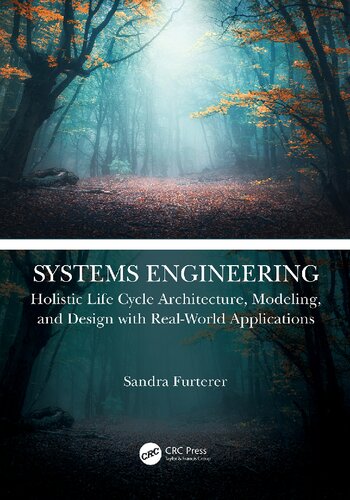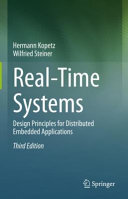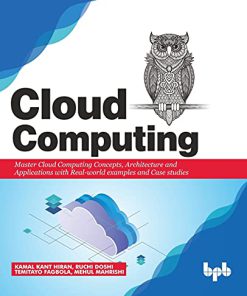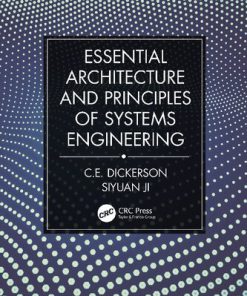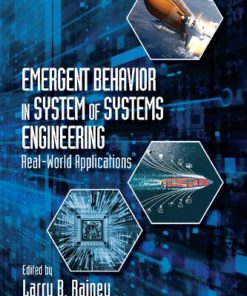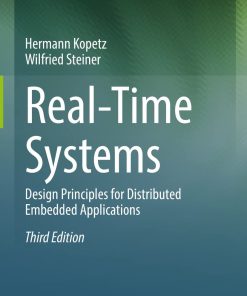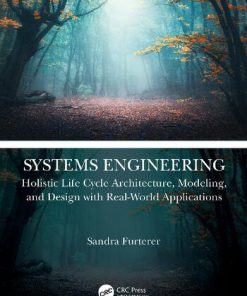Systems Engineering: Holistic Life Cycle Architecture Modeling and Design with Real-World Applications 1st Edition by Sandra Furterer 9781000509656 1000509656
$50.00 Original price was: $50.00.$25.00Current price is: $25.00.
Systems Engineering: Holistic Life Cycle Architecture Modeling and Design with Real-World Applications 1st Edition Sandra Furterer – Ebook Instant Download/Delivery ISBN(s): 9781000509656, 1000509656
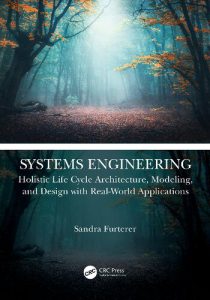
Product details:
- ISBN 10:1000509656
- ISBN 13:9781000509656
- Author: Sandra Furterer
Holistic Life Cycle Architecture Modeling and Design with Real-World Applications
Table contents:
Section 1 Systems Engineering Fundamentals
1 Systems Principles and Concepts
1.1 Introduction and Purpose of the Book
1.2 What Is a System?
1.3 Defining Systems Engineering
1.4 Why Is Systems Engineering Necessary
1.5 Systems Thinking History
1.6 Systems Principles
1.6.1 Complexity
1.6.2 Emergence
1.6.3 Hierarchy
1.6.4 Boundary
1.6.5 System Dynamics (Behavior, System Elements)
1.6.6 Systems Thinking
1.6.7 State and Behavior
1.6.8 Function
1.6.9 Abstraction
1.6.10 System Elements
1.6.11 Relations
1.6.12 Interactions
1.6.13 View
1.6.14 Parsimony
1.6.15 Networks
1.6.16 Dualism
1.6.17 Holism
1.6.18 Similarity/Differences
1.6.19 Separation of Concerns
1.6.20 Modularity
1.6.21 Encapsulation (Hide Internal Workings of System)
1.6.22 Change
1.7 Summary
1.8 Active Learning
Bibliography
2 Life Cycle Models for Systems Engineering
2.1 Purpose
2.2 Methodology, Process, and Tools
2.3 Life Cycle Methodologies
2.3.1 Vee Life Cycle Model
2.4 Summary
2.5 Active Learning
Bibliography
3 Systems Architecture for Model-Based Systems Engineering
3.1 Purpose
3.2 Systems Modeling Overview
3.3 Classification
3.3.1 An Object and a Class
3.3.2 Structure and Behavior
3.3.3 Class Diagram
3.4 Model Description
3.4.1 Systems Architecture Models
3.4.2 Mission Analysis Model within Phase 1, Concept of Operations
3.4.3 Systems Architecture and Requirements Model within Phase 2, System Architecture and Requirements
3.4.4 Information and Application Model within Phase 2, System Architecture and Requirements
3.4.5 Systems Design Model within Phase 3, System Design
3.4.6 Systems Verification and Validation Model within Phase 4, System Verification and Phase 5, System Validation
3.4.7 System Operations Model within Phase 6, Operations and Maintenance
3.4.8 Systems Engineering Planning
3.5 Summary
3.6 Active Learning Exercises
Bibliography
Section 2 Systems Design, Development, and Deployment Life Cycle: Service Applications and Tools
S.1 Section and Chapter Descriptions
S.2 Case Study Description
S.3 Women’s Healthcare Center
S.4 Food System to Reduce Food Insecurity
4 Concept of Operations Phase 1: Define Strategic Mission Goals
4.1 Purpose
4.2 Activities
4.3 Define Mission Strategy
4.4 Define Strategic Goals of Mission and Concept of Operations
4.5 Perform External, Internal, and SWOT Analyses
4.5.1 External Analysis
4.5.2 Internal Analysis
4.5.3 SWOT Analysis
4.6 Summary
4.7 Active Learning Exercises
References
5 Concept of Operations Phase 1: Define Mission Analysis
5.1 Purpose
5.2 Mission Analysis
5.2.1 Activities
5.2.2 Define Mission Analysis
5.2.2.1 Develop Project Charters
5.2.2.1.1 Project Charter Fields
5.2.2.2 Perform Stakeholder analysis
5.2.2.3 Collect Voice of Customer
5.2.2.4 Perform Conceptual Selection
5.2.2.5 Perform Risk Analysis
5.2.2.6 Risk assessment
5.2.2.7 Risk Handling Approach
5.2.2.7.1 Risk Handling Options
5.2.2.8 Risk Prioritization
5.2.2.9 Risk Cube
5.3 Summary
5.4 Active Learning Exercises
Bibliography
6 Requirements and Architecture Phase 2: Develop Logical Architecture
6.1 Purpose
6.2 Activities
6.3 Develop Logical Architecture
6.3.1 SIPOC Tool
6.3.2 Value System and Value Chain Models
6.3.3 Functional Decomposition Model
6.3.4 Use Case Diagrams
6.4 Summary
6.5 Active Learning Exercises
Bibliography
7 Requirements and Architecture Phase 2: Elicit Requirements
7.1 Purpose
7.2 Activities
7.3 Elicit Customer Requirements
7.3.1 Facilitate Process Scenarios to Create Process Architecture Maps (PAMs) and Use Cases
7.3.2 Food Systems Process Scenarios Use Cases Lists and Process Architecture Map Application
7.3.3 Create Use Cases
7.3.4 Food System Use Case
7.4 Summary
7.5 Active Learning Exercises
Bibliography
8 Requirements and Architecture Phase 2: Derive Requirements
8.1 Purpose
8.2 Activities
8.3 Derive Requirements
8.3.1 Customer Requirements
8.3.1.1 Requirements Terminology
8.3.2 Develop System Requirements
8.3.3 Develop Specialty Engineering Disciplines and Related Requirements
8.3.3.1 Software Engineering
8.3.3.2 Environmental Engineering
8.3.3.3 Safety Engineering Requirements
8.3.3.4 Security Engineering Requirements
8.3.3.5 Human Systems Integration Requirements
8.3.3.6 Women’s Healthcare Center Requirements
8.3.3.7 Food System Requirements
8.4 Develop Measurement Plan – Data Collection Plan, with Operational Definitions
8.4.1 Data Collection Plan
8.4.1.1 Critical to Satisfaction Criteria
8.4.1.2 Operational Definition
8.4.1.3 Food System Data Collection Plans
8.5 Develop Information Models
8.6 Food System Information Models
8.7 Develop Quality Management Plan
8.8 Summary
8.9 Active Learning Exercises
Bibliography
9 Detailed Design Phase 3
9.1 Purpose
9.2 Activities
9.3 Perform Detailed Design
9.3.1 Physical Architecture Model Hierarchy
9.3.2 Physical Architecture Model: Physical Block Diagram, and/or SysML Block Definition Diagram, and/or SysML Internal Block Diagram
9.3.3 System Elements
9.3.4 Quality Function Deployment (QFD)
9.3.5 Food System QFD House of Quality 1
9.4 System Design
9.5 Perform Systems Analysis
9.5.1 Trade-Off Analysis
9.5.2 Trade-Off Studies for Food Systems
9.5.3 Cost Analysis
9.5.4 Cost Analysis for Food Systems
9.5.5 Technical Risk Analysis with Failure Mode and Effect Analysis
9.5.5.1 Food System Failure Mode and Effect Analysis (FMEA)
9.5.6 Effectiveness Analysis Using Lean Analysis for a Manufacturing or Service System
9.5.6.1 Value Analysis
9.5.6.2 Waste Analysis
9.5.7 Food System Lean Analyses
9.5.8 N-squared Diagram to Identify Interface Points
9.5.8.1 Food System N-squared Diagrams
9.6 Summary
9.7 Active Learning Exercises
Bibliography
10 Implementation, Integration, Test and Verification, System Verification, and Validation within Phases 4 and 5
10.1 Purpose
10.2 Activities
10.3 Phase 4: Implementation, Integration, Test, and Verification
10.3.1 Perform System Implementation
10.3.1.1 Food System Implementation Strategies
10.3.2 Perform System Integration
10.3.2.1 Food System Integration Constraints
10.4 Phase 5: System Verification and Validation
10.4.1 Perform System Verification
10.4.1.1 Food System – System Verification List of Test Cases
10.4.1.2 Food System – System Verification Sample Test Cases
10.4.2 Perform System Validation
10.4.2.1 Food System – System Validation List of Test Cases
10.4.2.2 Food System Validation Sample Test Cases
10.5 Summary
10.6 Active Learning Exercises
Bibliography
11 Operation and Maintenance Phase 6
11.1 Purpose
11.2 Activities
11.2.1 Deploy System
11.2.2 Perform Training and Perform Certification
11.2.2.1 Food Systems Training Approach and Plans
11.2.3 Perform Risk Assessment
11.2.4 Perform Improvement and Maintenance Planning
11.2.4.1 Food System Improvement and Maintenance Plans
11.2.5 Perform Disposal and Retirement
11.2.5.1 Food System Disposal and Retirement Plan
11.3 Summary
11.4 Active Learning Exercises
Bibliography
12 Systems Engineering Planning
12.1 Purpose
12.2 Activities
12.3 Develop Systems Engineering Management Plan and Associated Plans
12.3.1 Assessment and Control Plan
12.3.2 Configuration Management Plan
12.3.3 Contractor Management Plan
12.3.4 Deployment Plan
12.3.5 Disposal and Retirement Plan
12.3.6 Information Management Plan
12.3.7 Interface Management Plan
12.3.8 Improvement and Maintainability Program Plan
12.3.9 Measurement Plan
12.3.10 Quality Management Plan
12.3.11 Risk Management Plan
12.3.12 Specialty Engineering Plan
12.3.13 System Development Plan
12.3.14 System Integration Plan
12.4 Summary
12.5 Active Learning Exercises
Bibliography
13 Model-Based Systems Engineering (MBSE)
13.1 Purpose
13.2 Description of Model-Based Systems Engineering
13.3 Benefits and Challenges of Implementing MBSE
13.3.1 Benefits
13.3.2 Challenges
13.4 Potential Future Research in MBSE
13.5 Summary
13.6 Active Learning Exercises
Bibliography
14 Lean, Iterative, and Agile Life Cycles that Can Be Used to Streamline System Design and Development Timelines
14.1 Purpose
14.2 Waterfall, Linear, or Predictive Life Cycle
14.3 Evolutionary or Incremental Life Cycle
14.4 Iterative Project Management, including Agile and Scrum
14.4.1 Agile Methodology
14.4.2 Scrum
14.4.3 Scrum Tools and Activities
14.5 Lean
14.5.1 Value Stream Mapping
14.5.2 Value Analysis
14.5.3 Waste Analysis
14.5.4 Why-Why Diagram and Five Whys
14.5.5 5S and Visual Management
14.5.6 Kaizen
14.5.7 Flow, Pull, and Kanban
14.5.8 Mistake Proofing
14.5.9 Standard Work
14.6 Systems Thinking and Theory of Constraints
14.7 Ideas from the Research Literature for Incorporating Lean Principles and Tools into the Systems Engineering Life Cycle
14.8 Summary
14.9 Active Learning Exercises
Bibliography
15 Holistic Culture and Change Management Concepts and Skills for Enhancing Systems Engineering Practices
15.1 Purpose
15.2 Change and Change Management
15.2.1 What Is Change?
15.2.2 Making Change Happen
15.2.3 What Is Culture?
15.2.4 What Is Culture Change?
15.2.4.1 Symbols: Organizational Logos, Office Layouts, Parking Lots, Artwork in the Hallways
15.2.4.2 Power Structures: Managerial Groupings and the Most Powerful Functional Areas
15.2.4.3 Organizational Structures: Organizational Hierarchy and Informal Structures
15.2.4.4 Control Systems: Performance Measurement and Reward Systems
15.2.4.5 Rituals and Routines: The Christmas Party and Meetings around the Water Cooler
15.2.4.6 Stories and Myths: Stories about Innovative Curriculum and Experiential Learning
15.2.4.7 The Paradigm: Student Satisfaction and Excellence in Teaching
15.3 Structures
15.4 People Skills
15.4.1 Teamwork
15.4.2 Understanding What Teams Need
15.4.3 Team Stages for Growth
15.4.4 Lencioni Model of Team Dysfunction
15.4.5 Psychological Safety (Edmondson, 2021)
15.4.6 Rules of Engagement
15.4.7 Team Diversity
15.5 Techniques That Can be Used in Each Phase of the Vee Life Cycle to Enhance the Communication with Customers and Stakeholders
15.5.1 Phase 1 – Concepts of Operations
15.5.1.1 Concept Generation Applying the IDA Method (Furterer, 2020)
15.5.2 Phase 2 – Requirements and Architecture
15.5.2.1 Process Scenarios
15.5.3 Phase 3 – Design
15.5.3.1 Design Idea Generation
15.5.4 Phases 4 and 5 – Verification and Validation
15.5.4.1 Test Cases
15.5.5 Phase 6 – Operations and Maintenance
15.5.5.1 Standard Work
15.6 Summary
15.7 Active Learning Exercises
People also search:
systems engineering: holistic life
systems engineering lifecycle management
systems engineering life cycle process
systems engineering lifecycle
holistic engineering
You may also like…
Computers - Applications & Software
Real Time Systems Design Principles for Distributed Embedded Applications 3rd Edition Hermann Kopetz
Engineering - Engineering Technology
Modeling of Dynamic Systems with Engineering Applications 2nd Edition Clarence W. De Silva
Engineering - Engineering Technology
Computers - Applications & Software
Real Time Systems Design Principles for Distributed Embedded Applications 3rd Edition Hermann Kopetz
Business & Economics - Others
Arts - Architecture

